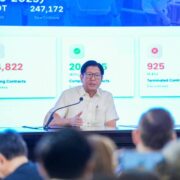Jobless Pinoys at 1.8M in February, down from 2.15M

The number of unemployed Filipinos dropped to 3.5 percent in February, easing from 4.5 percent in January, the Philippine Statistics Authority (PSA) reported on Thursday.
A nationwide survey of 11,149 households showed there were 1.8 million jobless Filipinos in February, down from 2.15 million in January.
The PSA said this was the second lowest unemployment reading since December when the number of jobless Filipinos numbered some 1.6 million.
At a press conference, National Statistician Claire Dennis Mapa attributed the decline to vacancies that emerged after the reopening of classes in colleges and universities as well as the start of the planting and harvesting season.
“February is the opening of classes in colleges so there were opportunities for activities related to retail trade. That’s one contributor,” Mapa said. “In agriculture, there was a planting and harvesting season.”
The jobs data showed that the wholesale and retail sector showed the biggest month-on-month increase in employment after absorbing 1.61 million new workers.
This was followed by agriculture (+1.03 million), accommodations and food service (+325,000) and construction (+231,000).
The agriculture sector, however, showed mixed results because respondents reported losses due to crop damage caused by extreme heat. The PSA said fishing and aquaculture shed the most jobs in February at 402,000.Fewer job seekers
The PSA data showed the softer unemployment rate coincided with an annualized decline in the number of people age 15 years old and above who actively looked for work during the period.
The Labor Force Participation Rate (LFPR) in February this year was posted at 64.8 percent, lower than the 66.6 percent recorded LFPR in February 2023, but higher than the 61.1 percent posted in January 2024.The reported participation rate in February put the labor force at 50.75 million Filipinos aged 15 years old and over. In February 2023, the labor force was at 51.27 million while 48.09 million were in the labor force in January 2024.
The drop in participation was most pronounced among young people (-669,000) and women (-404,000), the survey found, with “household family duties” and “schooling” cited as top reasons for leaving the workforce.
According to the jobs data, job quality was slowly improving with underemployment at 12.4 percent in February, lower than 13.9 percent in January.
Leonardo Lanzona, labor economist at Ateneo de Manila University, believed that the government could have done more to improve the quality of jobs amid rapid automation.
“In the midst of the digital transformation of technology, the limited government assistance to unemployed people has forced them to look for and accept lower quality jobs compared to what they would normally accept,” Lanzona said. INQ

















